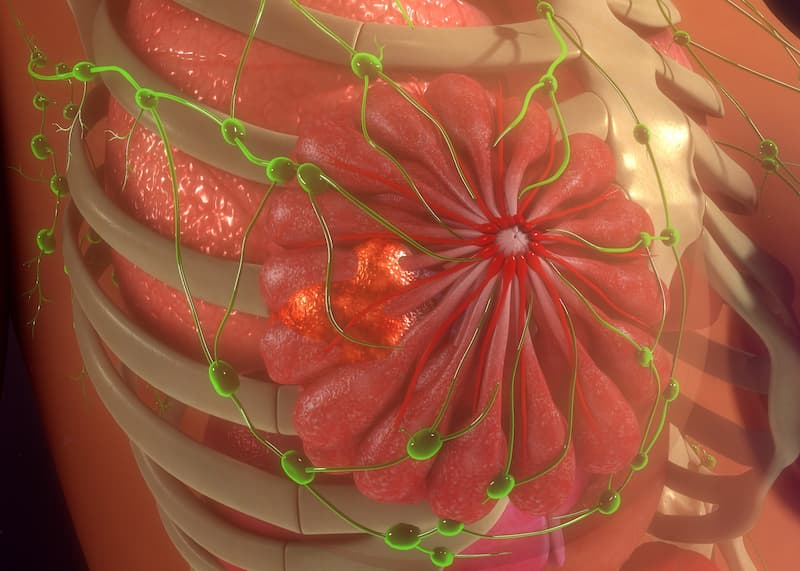Lasofoxifene Combo Yields Meaningful Activity in ER+/HER2– Breast Cancer
The anti-tumor activity of lasofoxifene plus abemaciclib does not appear to be compromised by co-occurring alterations that confer resistance among patients with estrogen receptor–positive HER2-negative breast cancer.
The phase 3 ELAINE-3 study (NCT05696626) is currently enrolling patients to compare the safety and efficacy of lasofoxifene plus abemaciclib with that of fulvestrant and abemaciclib. Confirmatory results may provide a practice changing option for this subset of patients.

Combination treatment with Lasofoxifene (Fablyn) and abemaciclib (Verzenio) was tolerable and yielded meaningful clinical activity in previously treated patients with estrogen receptor (ER)–positive HER2-negative ESR1-mutated breast cancer, according to findings from the phase 2 ELAINE-2 trial (NCT04432454) presented at the 2023 American Society of Clinical Oncology (ASCO) Annual Meeting.
According to results presented by Senthil Damodaran, MD, PhD, an assistant professor at The University of Texas MD Anderson Cancer Center in Houston, ESR1-mutant allele fractions (MAF) decreased during treatment with the doublet suggesting there was target engagement as well.ESR1 MAF was analyzed at baseline and week 4 in ctDNA for 26 patients and decreased in 80.8% of patients at week 4 including 53.8% whose ESR1 MAF was undetectable.
As of April 2023, patients (n = 29) experienced a clinical benefit rate (CBR) of 65.5% (95% CI, 47.3%-80.1%). There were 6 patients continuing treatment and those who discontinued did so because of disease progression (n = 17), an adverse event (AE; n = 1), withdrawal (n = 3), or other (n = 2). Patients with measurable lesions (n = 18) expereinced an objective response rate (ORR) of 55.6% (95% CI, 33.7%-75.4%) with a median time to response (TTR) of 5.7 months and a median duration of response (DOR) of 6.4 months.
As of January 2023, the 6-, 12-, and 18-month PFS rates were 76.1% (54.4%-88.5%), 56.1% (39.4%-72.8%), and 38.8% (20.0%-57.3%), respectively. The median PFS was 56.0 weeks (95% CI, 31.9-not estimable) and PFS was achieved over 96 weeks for 27.6% of patients. Further, median OS was not estimable at the time.
Patients with the co-existing genomic alterations (n = 26) CCND1 amplification (n = 6) and FGFR1 amplification (n = 5) both experienced a 100% CBR and a median PFS of 72 weeks. Further, those with PIK3CA (n = 8) and TP53 (n = 12) mutations experienced CBRs of 63% and 58%, respectively, with a median PFS of 36 weeks and 72 weeks, respectively. Among 4 patients who previously received abemaciclib, 2 achieved clinical benefit and 1 remained on treatment until week 40 with stable disease.
Investigators noted that the “antitumor activity of lasofoxifene/abemaciclib was not compromised by co-occuring alterations that confer endocrine resistance.”
Patients were a median age of 60 years old, received a median of 2 prior lines of therapy, and almost all (96.6%) received a previous CDK4/6 inhibitor, for a median duration of 2 years. Most patients received prior fulvestrant (79.3%) and had visceral disease (55.2%). Prior chemotherapy for metastatic breast cancer was administered at a rate of 48.3%.
The most common ESR1 mutations at baseline were Y537S (65.5%), D538G (44.8%), Y536N (27.6%), and Y537C (10.3%). Additionally, 48.3% of patients had polyclonal ESR1 mutations.
Patients received 5 mg of oral lasofoxifene daily with 150 mg of abemaciclib twice a day until disease progression, death, withdrawal, or toxicity. The open-label, single-arm study’s primary end point was safety and tolerability with secondary end points including PFS, CBR, and ORR, DOR, and TTR.
The phase 3 ELAINE-3 study (NCT05696626) is currently enrolling patients to compare the safety and efficacy of lasofoxifene plus abemaciclib with that of fulvestrant and abemaciclib. Confirmatory results may provide a practice changing option for this subset of patients.
Safety
Most treatment-emergent AEs (TEAEs) were grade 1 or 2 and there were no deaths on treatment, however, a patient discontinued treatment due to grade 2 diarrhea. No patients received lasofoxifene dose reductions, but abemaciclib was reduced to 100 mg in 20.7% of patients.
The most frequent any grade TEAEs were diarrhea (82.8%), nausea (51.7%), fatigue (37.9%), vomiting (31.0%), anemia (27.6%), and dyspnea (27.6%). Grade 3 events included fatigue (3.4%), vomiting (3.4%), anemia (10.3%), constipation (3.4%), hypokalemia (10.3%), and falls (6.9%).
Thrombotic events
Scan-identified venous thromboembolism occurred in 3 patients (10.3%) on the trial. The first patient experienced a symptomatic spontaneous event at week 64 with a confirmed grade 3 pulmonary embolism. Following anticoagulation, the patient developed bleeding complications and withdrew from the study at 72 weeks; at the time of the event, they had an ongoing PR with a 50% reduction of 8-cm sum diameter liver metastases of 30 weeks duration.
The second patient experienced a deep vein thrombosis following elective knee surgery as well as a pulmonary embolism at week 24 and reinitiated therapy after a successful anticoagulation. Although a clinical benefit was achieved, disease progression occurred at week 36.
Finally, the third patient experienced an asymptomatic pulmonary embolism at week 72 and an asymptomatic popliteal deep vein thrombosis upon further evaluation. After anticoagulation, therapy was reinitiated and the patient had a PR of 60 weeks, however, after 100 weeks of treatment disease progression occurred.
Disclosures: Damodaran has a consulting or advisory role with Taiho Oncology and has received research funding from AstraZeneca, EMD Serono, Guardant Health, Novartis, Sermonix Pharmaceuticals, and Taiho Pharmaceutical.
Reference
Damodaran S, Moore HCF, Anderson IC, et al. Lasofoxifene (LAS) plus abemaciclib (Abema) for treating ESR1-mutated ER+/HER2- metastatic breast cancer (mBC) after progression on prior therapies: ELAINE 2 study update. J Clin Oncol. 2023;41(suppl 16):1057. doi:10.1200/JCO.2023.41.16_suppl.1057